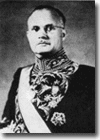| Our Publications | ||
| Books by Title | ||
| Books by Author | ||
| Books by Country | ||
| E-books | ||
| About | ||
| Orchid Press E-books | ||
| Distributed E-books | ||
| Our Bookshop | ||
| About Us | ||
| Browse Shop | ||
| How to Buy | ||
| Contact Us | ||
| WE BUY BOOKS AND LIBRARIES | ||
|
||
Profiles

R. H. van Gulik
…as diplomat, linguist and Sinologist
By Wilt L. Idema
(an extract from the article Dutch Sinology: Past, Present and Future, in Europe Studies Asia, London 1995, available in Asia from Orchid Press)
The most famous Dutch diplomat who continued to publish on Chinese subjects throughout his long career in the foreign service, was of course R. H. van Gulik (1910-67). van Gulik was a precocious student, who as early as in his highschool days had engaged in linguistic research. He studied Chinese at Leiden but eventually got his doctorate from Utrecht University on a thesis in Indian studies. Throughout his life van Gulik took delight in writing on the hobbies and pursuits of the traditional Chinese scholar, subjects up to his time as a rule neglected by academic sinologists. The subjects he dealt with include Chinese antiques and connoisseurship, the Chinese lute, and the gibbon. All of his publications were not only informed by an extensive knowledge of Chinese sources and secondary materials in a wide variety of languages, but also by personal experience. van Gulik was an avid collector of Chinese books and curios, he personally practised Chinese painting and calligraphy, he was an expert musician on the ku ch’in, and at various times in his life kept gibbons as pets. van Gulik’s interest in rare books led him to the discovery of the erotic colour prints of the Ming dynasty, which in turn stimulated him to write his well known Sexual Life in Ancient China: A Preliminary Survey of Chinese Sex and Society From c. 1500 BC till 1644 AD (1961), a daring adventure in a still prudish age.
van Gulik’s interest in Chinese law, dating back to his student days, and in the detective novel, resulted in his monograph T’ang yin pi shih: Parallel Cases from Under the Pear Tree-A 13th Century Manual of Jurisprudence and Detection (1956) and in his translation of the first part of the traditional Chinese novel Wu Tse t’ien ssu ta ch’i an as Dee Gong An: Three Murder Cases Solved by Judge Dee: An Old Chinese detective Novel (1949). This latter, partial translation provided the model for his own Judge Dee Novels, which maintain Ti Jen chieh as the main character but which use the life and customs of the Ming dynasty for their social setting. van Gulik illustrated these novels himself with drawings in the style of traditional Chinese woodcuts. These fifteen or so Judge Dee novels, written during the fifties and sixties, made van Gulik a bestseller author, known widely outside diplomatic or academic circles. His Judge Dee novels were translated into many languages, including Dutch (almost all were originally written in English), adapted as comics, serialized on television and made into movies. van Gulik’s collection of Chinese books, including many rare materials, was eventually acquired by the Sinological Institute of Leiden University.
[Read another profile of R. H. van Gulik as popular author]
PO Box 70, Trinity TB, NL, A0C 2S0, Canada
Telephone: +1 709-330-4703